Famennian
The Famennian is the latter of two faunal stages in the Late Devonian epoch. It lasted from 372.2 million years ago to 358.9 million years ago. It was preceded by the Frasnian stage and followed by the Tournaisian stage.
| Famennian | |
|---|---|
| 372.2 ± 1.6 – 358.9 ± 0.4 Ma | |
| Chronology | |
Events of the Devonian Period -420 — – -415 — – -410 — – -405 — – -400 — – -395 — – -390 — – -385 — – -380 — – -375 — – -370 — – -365 — – -360 — – Key events of the Devonian Period. Axis scale: millions of years ago. | |
| Etymology | |
| Name formality | Formal |
| Usage information | |
| Celestial body | Earth |
| Regional usage | Global (ICS) |
| Time scale(s) used | ICS Time Scale |
| Definition | |
| Chronological unit | Age |
| Stratigraphic unit | Stage |
| Time span formality | Formal |
| Lower boundary definition | FAD of the Conodont Palmatolepis triangularis LAD of the Conodonts Ancyrodella and Ozarkodina and the Goniatites Gephuroceratidae and Beloceratidae |
| Lower boundary GSSP | Coumiac quarry, Montagne Noire, France 43.4613°N 3.0403°E |
| GSSP ratified | 1993[4] |
| Upper boundary definition | FAD of the Conodont Siphonodella sulcata (discovered to have biostratigraphic issues as of 2006).[5] |
| Upper boundary GSSP | La Serre, Montagne Noire, France 43.5555°N 3.3573°E |
| GSSP ratified | 1990[6] |
It was during this age that tetrapods first appeared. In the seas, a novel major group of ammonoid cephalopods called clymeniids appeared, underwent tremendous diversification and spread worldwide, then just as suddenly went extinct.
The beginning of the Famennian is marked by a major extinction event, the Kellwasser Event, and the end with a smaller but still quite severe extinction event, the Hangenberg Event.
North American subdivisions of the Famennian include the Chautauquan, Canadaway, Conneaut, Conneautan, Conewango and Conewangan.
Name and definition
The Famennian stage was proposed in 1855 by Belgian geologist André Hubert Dumont and was accepted for the upper stage of the Upper Devonian by the Subcommission on Devonian Stratigraphy in 1981.[7] It is named after Famenne, a natural region in southern Belgium.
Famennian life
Placoderms
| Placoderms of the Fammenian | ||||
|---|---|---|---|---|
| Taxa | Presence | Location | Description | Images |
| Dinichthys | Ohio Shale, Ohio & Louisiana Limestone, Missouri | A giant predatory arthrodire placoderm. It was previously used as a wastebasket taxon for many unrelated large arthrodires, including species now assigned to Eastmanosteus, Titanichthys and the similar but not closely related Dunkleosteus. |
 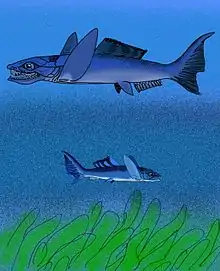   Dunkleosteus marsaisi, this species might belong to Eastmanosteus instead.
 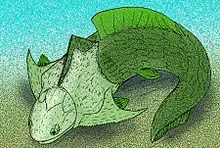 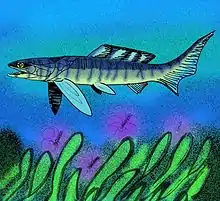 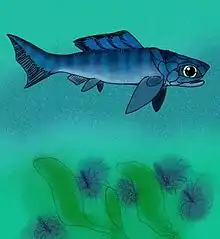   | |
| Diplognathus | Upper Famennian | Cleveland Shale, Ohio | An arthrodire placoderm of the superfamily Dinichthyloidea. | |
| Dunkleosteus | Lost Burro Formation & Ohio Shale, North America Belgium[8] Morocco[9] |
A dunkleosteid arthrodire with many species, some of them being among the largest placoderms to have existed. | ||
| Eastmanosteus licharevi | Lipetsk, Russia | A poorly known species of dunkleosteid arthrodire in the genus Eastmanosteus. | ||
| Gorgonichthys | Upper Famennian | Cleveland Shale, Ohio | A giant yet relatively lightly build arthrodire placoderm of the superfamily Dinichthyloidea. Gorgonichthys clarki is estimated to have reached 6 meters in length. | |
| Groenlandaspis | Cosmopolitan, except eastern Asia | An arthrodire placoderm | ||
| Gymnotrachelus | Cleveland Shale, Ohio | A superficially barracuda-like selenosteid arthrodire placoderm. | ||
| Heintzichthys | Europe North America |
An arthrodire placoderm of the superfamily Dinichthyloidea. | ||
| Selenosteus | Cleveland Shale, Ohio | A selenosteid arthrodire placoderm. | ||
| Stenosteus | Cleveland Shale, Ohio | A selenosteid arthrodire placoderm. | ||
| Titanichthys | Late Devonian | Morocco; North America | A giant, possibly filter-feeding, arthrodire placoderm of the superfamily Dinichthyloidea. | |
Cartilaginous fish
| Cartilaginous fish of the Fammenian | ||||
|---|---|---|---|---|
| Taxa | Presence | Location | Description | Images |
| Stethacanthus | Shar'yu River, Chernyshev Ridge, Russia Cleveland Shale, Ohio |
|||
Ray-finned fish
| Actinopterygii of the Fammenian | ||||
|---|---|---|---|---|
| Taxa | Presence | Location | Description | Images |
| Tegeolepis | Late Devonian | Ohio, United States | ||
Coelacanths
| Actinistia of the Fammenian | ||||
|---|---|---|---|---|
| Taxa | Presence | Location | Description | Images |
| Serenichthys | Witpoort Formation, Eastern Cape, South Africa | A basal actinistian of the family Diplocercidae | ||
Tetrapodomorphs (non-ichthyostegalian)
| Tetrapodomorph fish of the Fammenian | ||||
|---|---|---|---|---|
| Taxa | Presence | Location | Description | Images |
| Cabonnichthys | Canowindra, Australia | A genus of tristichopterid fish |
  | |
| Gooloogongia | Canowindra, Australia | A genus of rhizodontid fish that reached about 90 cm in length. | ||
| Hyneria | Upper Famennian | Catskill Formation & Red Hill Shale, Pennsylvania | Hyneria was a large tristichopterid fish, estimated at 2.5–3.7 m in total length | |
| Mandageria | Mandagery Sandstone, Canowindra, Australia | A genus of tristichopterid fish | ||
Ichthyostegalia
| Ichthyostegalians of the Fammenian | ||||
|---|---|---|---|---|
| Taxa | Presence | Location | Description | Images |
| Acanthostega | Britta Dal Formation, East Greenland |    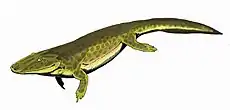  | ||
| Densignathus | Upper Famennian | Catskill Formation & Red Hill Shale, Pennsylvania | ||
| Hynerpeton | Upper Famennian | Catskill Formation & Red Hill Shale, Pennsylvania | ||
| Ichthyostega | Evieux Formation, Belgium Britta Dal Formation, East Greenland |
|||
| Jakubsonia | Lower Famennian | Russia | ||
| Metaxygnathus | Cloghnan Shale, New South Wales, Australia | Previously thought to be a lobe-finned fish. | ||
| Sinostega | Zhongning Formation, Ningxia Hui Autonomous Region, China | The first Devonian tetrapod to be found in Asia | ||
| Tulerpeton | Andreyevka, Tula Oblast, Russia | |||
| Ventastega | Ketleri Formation, Courland Peninsula, Latvia | |||
| Ymeria | Celsius Bjerg Group, Greenland | A smaller close relative of Ichtyostega. | ||
References
- Parry, S. F.; Noble, S. R.; Crowley, Q. G.; Wellman, C. H. (2011). "A high-precision U–Pb age constraint on the Rhynie Chert Konservat-Lagerstätte: time scale and other implications". Journal of the Geological Society. London: Geological Society. 168 (4): 863–872. doi:10.1144/0016-76492010-043.
- Kaufmann, B.; Trapp, E.; Mezger, K. (2004). "The numerical age of the Upper Frasnian (Upper Devonian) Kellwasser horizons: A new U-Pb zircon date from Steinbruch Schmidt(Kellerwald, Germany)". The Journal of Geology. 112 (4): 495–501. Bibcode:2004JG....112..495K. doi:10.1086/421077.
- Algeo, T. J. (1998). "Terrestrial-marine teleconnections in the Devonian: links between the evolution of land plants, weathering processes, and marine anoxic events". Philosophical Transactions of the Royal Society B: Biological Sciences. 353 (1365): 113–130. doi:10.1098/rstb.1998.0195.
- Klapper, G.; Feist, R.; Becker, R.; House, M. (December 1993). "Definition of the Frasnian/Famennian Stage boundary". 16 (4): 433–441. Retrieved 19 December 2020. Cite journal requires
|journal=(help) - Kaiser, Sandra (1 April 2009). "The Devonian/Carboniferous boundary stratotype section (La Serre, France) revisited". Newsletters on Stratigraphy. 43: 195–205. doi:10.1127/0078-0421/2009/0043-0195. Retrieved 7 December 2020.
- Paproth, Eva; Feist, Raimund; Flajs, Gerd (December 1991). "Decision on the Devonian-Carboniferous boundary stratotype" (PDF). Episodes. 14: 331–336.
- Thorez, Jacques; Dreesen, Roland; Streel, Maurice (2006). "Frasnian". Geologica Belgica. 9 (1–2): 27–45. Retrieved 16 March 2013.
- Denison, Robert (1978). "Placodermi". Handbook of Paleoichthyology. 2. Stuttgart New York: Gustav Fischer Verlag. p. 128. ISBN 978-0-89574-027-4.
- Murray, A.M. (2000). "The Palaeozoic, Mesozoic and Early Cenozoic fishes of Africa". Fish and Fisheries. 1 (2): 111–145. doi:10.1046/j.1467-2979.2000.00015.x.
